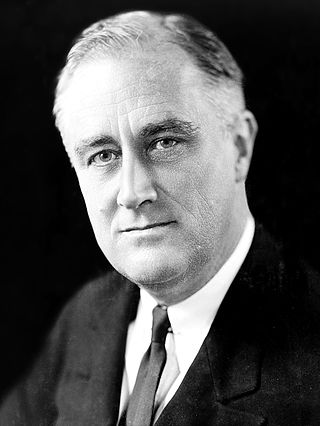Related Research Articles

The 1832 United States presidential election was the 12th quadrennial presidential election, held from Friday, November 2 to Wednesday, December 5, 1832. Incumbent president Andrew Jackson, candidate of the Democratic Party, defeated Henry Clay, candidate of the National Republican Party.

The 1848 United States presidential election was the 16th quadrennial presidential election, held on Tuesday, November 7, 1848. In the aftermath of the Mexican–American War, General Zachary Taylor of the Whig Party defeated Senator Lewis Cass of the Democratic Party.

The 1932 United States presidential election was the 37th quadrennial presidential election, held on Tuesday, November 8, 1932. The election took place against the backdrop of the Great Depression. The incumbent Republican President Herbert Hoover was defeated in a landslide by Democrat Franklin D. Roosevelt, the governor of New York and the vice presidential nominee of the 1920 presidential election. Roosevelt was the first Democrat in 80 years to simultaneously win an outright majority of the electoral college and popular vote, a feat last accomplished by Franklin Pierce in 1852, as well as the first Democrat in 56 years to win a majority of the popular vote, which was last done by Samuel J. Tilden in 1876. Roosevelt was the last sitting governor to be elected president until Bill Clinton in 1992. Hoover became the first incumbent president to lose an election to another term since William Howard Taft in 1912, and the last to do so until Gerald Ford lost 44 years later. The election marked the effective end of the Fourth Party System, which had been dominated by Republicans. It was the first time since 1916 that a Democrat was elected president.

Each of the 50 U.S. states, the District of Columbia, and territories of the United States holds either primary elections or caucuses to help nominate individual candidates for president of the United States. This process is designed to choose the candidates that will represent their political parties in the general election.

The American Independent Party (AIP) is a far-right political party in the United States that was established in 1967. The AIP is best known for its nomination of Democratic then-former Governor George Wallace of Alabama, who carried five states in the 1968 presidential election running on a populist, hard-line anti-Communist, pro-"law and order" platform, appealing to working-class white voters and widely understood by political analysts as having pro-segregationist or white supremacist undertones, against Richard Nixon and Hubert Humphrey. In 1976, the party split into the modern American Independent Party and the American Party. From 1992 until 2008, the party was the California affiliate of the national Constitution Party. Its exit from the Constitution Party led to a leadership dispute during the 2008 election.

The Democratic National Convention (DNC) is a series of presidential nominating conventions held every four years since 1832 by the United States Democratic Party. They have been administered by the Democratic National Committee since the 1852 national convention. The primary goal of the Democratic National Convention is to officially nominate a candidate for president and vice president, adopt a comprehensive party platform and unify the party. Pledged delegates from all fifty U.S. states, the District of Columbia and the American territories, and superdelegates which are unpledged delegates representing the Democratic establishment, attend the convention and cast their votes to choose the party's presidential candidate. Like the Republican National Convention, the Democratic National Convention marks the formal end of the primary election period and the start of the general election season. Since the 1980s the national conventions have lost most of their importance and become mostly just ceremonial coronation events for the respective candidate, as since the full establishment of primary contests in that time the winning nominees of both parties have always been clear long time before the convention. In 2020, both major parties, and many minor parties, replaced their usual in-person conventions with virtual programs due to the COVID-19 pandemic.
In American politics, a superdelegate is a delegate to a presidential nominating convention who is seated automatically.

The 1920 Republican National Convention nominated Ohio Senator Warren G. Harding for president and Massachusetts Governor Calvin Coolidge for vice president. The convention was held in Chicago, Illinois, at the Chicago Coliseum from June 8 to June 12, 1920, with 940 delegates. Under convention rules, a majority plus one, or at least 471 of the 940 delegates, was necessary for a nomination.
A delegate is a person selected to represent a group of people in some political assembly of the United States.

The 1912 Republican National Convention was held at the Chicago Coliseum, Chicago, Illinois, from June 18 to June 22, 1912. The party nominated President William H. Taft and Vice President James S. Sherman for re-election for the 1912 United States presidential election.

The 1852 Whig National Convention was a presidential nominating convention held from June 16 to June 21, in Baltimore, Maryland. It nominated the Whig Party's candidates for president and vice president in the 1852 election. The convention selected General-in-Chief Winfield Scott for president and U.S. secretary of the navy William A. Graham for vice president.
The 1940 Republican National Convention was held in Philadelphia, Pennsylvania, from June 24 to June 28, 1940. It nominated Wendell Willkie of New York for president and Senator Charles McNary of Oregon for vice president.

The 1832 Democratic National Convention was held from May 21 to May 23, 1832, in Baltimore, Maryland. In the first presidential nominating convention ever held by the Democratic Party, incumbent President Andrew Jackson was nominated for a second term, while former Secretary of State Martin Van Buren was nominated for vice president.
A brokered convention, in US politics, can occur during a presidential election when a political party fails to choose a nominee on the first round of delegate voting at the party's nominating convention.

Voters of the Republican Party elected state delegations to the 2012 Republican National Convention in presidential primaries. The national convention then selected its nominee to run for President of the United States in the 2012 presidential election. There were 2,286 delegates chosen, and a candidate needed to accumulate 1,144 delegate votes at the convention to win the nomination. The caucuses allocated delegates to the respective state delegations to the national convention, but the actual election of the delegates were, many times, at a later date. Delegates were elected in different ways that vary from state to state. They could be elected at local conventions, selected from slates submitted by the candidates, selected at committee meetings, or elected directly at the caucuses and primaries.
The 2012 Libertarian National Convention, in which delegates of the Libertarian Party (LP) chose the party's nominees for president and vice president in the 2012 general election, was held May 2–6, 2012, in Las Vegas, Nevada, at the Red Rock Resort Spa and Casino. Former Governor of New Mexico Gary Johnson won the presidential nomination on the first ballot. Retired California state court judge Jim Gray won the vice presidential nomination, also on the first ballot. The convention also chose to replace most of the Libertarian National Committee party officers and members-at-large.

The 2016 Green Party presidential primaries were a series of primaries, caucuses and state conventions in which voters elected delegates to represent a candidate for the Green Party's nominee for President of the United States at the 2016 Green National Convention. The primaries, held in numerous states on various dates from January to July 2016, featured elections publicly funded and held as an alternative ballot, concurrent with the Democratic and Republican primaries, and elections privately funded by the Green Party, held non-concurrently with the major party primaries. Over 400 delegates to the Green National Convention were elected in these primaries, with a candidate needing a simple majority of these delegates to become the party's nominee for president.

The 2020 Green Party presidential primaries were a series of primary elections, caucuses and state conventions in which voters elected delegates to represent a candidate for the Green Party's nominee for President of the United States at the 2020 Green National Convention. The primaries, were held in numerous U.S. states on various dates from early spring into early summer of 2020, and featured elections publicly funded, concurrent with the Democratic Party and Republican Party primaries, and elections privately funded by the Green Party, held non-concurrently with the major party primaries.

The 2020 Libertarian National Convention delegates selected the Libertarian Party nominees for president and vice president in the 2020 United States presidential election. Primaries were held, but were preferential in nature and did not determine delegate allocation. The convention was originally scheduled to be held from May 21 to May 25 at the JW Marriott Austin luxury hotel in downtown Austin, Texas. On April 26, all reservations at the JW Marriott Austin were canceled in response to the COVID-19 pandemic, leaving the convention oversight committee to seek another venue for a possible July date.

The 2020 Green National Convention (GNC) or presidential nominating convention was an event in which delegates of the Green Party of the United States (GPUS) chose its nominees for president and vice president in the 2020 U.S. presidential election. The convention was originally scheduled to be held July 9–12, 2020, at Wayne State University in Detroit, Michigan, but it was decided to instead hold the convention online due to the COVID-19 pandemic.
References
- ↑ Peter R. Kann & Lee Hudson Teslik (February 4, 2008), "Backgrounder: The Role of Delegates in the U.S. Presidential Nominating Process", Council on Foreign Relations via The New York Times.
- ↑ John G. Geer, Wendy J. Schiller & Jeffrey A. Segal, Gateways to Democracy: An Introduction to American Government (2d ed.: Wadsworth/Centgage Learning 2014), p. 406.
- 1 2 Sabato, Larry; Ernst, Howard R. Encyclopedia of American Political Parties and Elections . Infobase Publishing. 2006. p. 216. ISBN 9780816058754.
- 1 2 3 Wiessler, David (March 4, 2008) "Factbox: Presidential political terms", Reuters.
- ↑ Dann, Carrie (May 26, 2016). "Trump Hit the 'Magic Number.' So, What Does That Mean?". NBC News . Retrieved May 26, 2016.
- 1 2 3 Nathaniel Rakich, "What Makes a Presidential Nominee 'Presumptive'?", The New Republic (May 3, 2016).
- 1 2 3 4 Stephen K. Medvic (2013). Campaigns and Elections: Players and Processes (2d ed.). Routledge. p. 144. ISBN 9781136265556.
- ↑ Barbara Norrander, The Imperfect Primary: Oddities, Biases, and Strengths of U.S. Presidential Nomination Politics (2d ed.: Routledge, 2015), p. 25.
- ↑ Eleanor Clift & Matthew Spieler, Selecting a President (Macmillan, 2012), p. 41.
- ↑ Norrander, p. 25.
- ↑ Ben Zimmer (June 10, 2008), "The Presumptive Nominee, I Presume?", Thinkmap Visual Thesaurus.